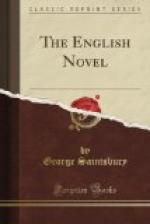by some people who are miserable if they cannot classify.
It certainly deals with pirates, and pieces of eight,
and adventures by land and sea; but the manner of
dealing—the style and narrative and the
delineation of the chief character, the engaging villain
John Silver—is about as little puerile
as anything that can be imagined. From that time
Stevenson’s reputation was assured. Ill
health, a somewhat restless disposition, and an early
death prevented him from accomplishing any great bulk
of work: and the merit of what he did varied.
Latterly he took to a teasing process of collaboration,
which his sincerest admirers could have willingly
spared. But his last completed book,
Catriona
(1893), seemed to some judges of at least considerable
experience the best thing he had yet done, especially
in one all-important respect—that he here
conquered either an unwillingness to attempt or an
inability to achieve the portraiture of feminine character,
which his books had previously displayed. The
general opinion, too, was that the unfinished
Weir
of Hermiston (1897), which he left a fragment at
his death, was the best and strongest thing he had
done, while it showed in particular a distinct relinquishment,
for something freer and more spontaneous, of the effective
but also rather affected and decidedly laboured style
in which he had hitherto written. For us, however,
his style is of less importance than the fact that
he applied it almost wholly to the carrying out of
that rejuvenescence of romance of which we have been
speaking, and which may be taken, as anybody pleases,
either for a mere alternative to the domestic novel
or as a definite revolt against it. It was speedily
taken up by writers mostly still living, and so not
to be dwelt on now.
Very late in the century the genius of Mr. William
Morris turned from verse to prose tale-telling in
a series of romances which caught the fancy neither
of the public nor of the critics as a whole, but which
seem to some whom the gods have made not quite uncritical
to be, if rightly taken, of much accomplishment, and
of almost more promise and suggestion. These,
seven or eight in number, from The House of the
Wulfings (1889) to The Sundering Flood,
published after the author’s death in 1898,
were actual romances—written in a kind of
modernised fifteenth-century English, and dealing,
some with far back incidents of the conflict between
Romans and “Barbarians,” most with the
frank no-time and no-place of Romance itself.
They came at an unfortunate moment, when the younger
generation of readers were thinking it proper to be
besotted with crude realism or story-less impressionism,
and when some at least of those who might have welcomed
them earlier had left their first faith in poetry
or poetic prose. There was, moreover, perhaps
some genuine dislike, and certainly a good deal of
precisian condemnation, of the “Wardour Street”
dialect. Yet there was no sham in them:




